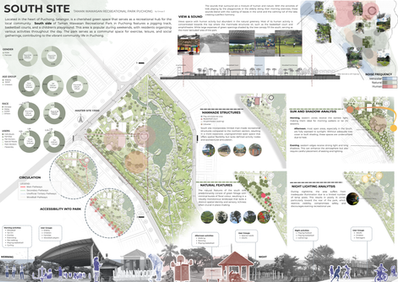ARCHITECTURAL DESIGN IV
ARC60508
PROJECT 1A
PROJECT 1A
SITE ANALYSIS & DESIGN RESPONSE - DESIGN FOR COMMUNITY
(20% GROUP)
PROJECT BRIEF
INTRODUCTION
Architectural Design IV (September 2024) begins by emphasizing the importance of both the environment and the community, highlighting architecture's role in shaping meaningful connections and promoting a sustainable future.
The Site Analysis & Design Response component provides the foundation for Projects 1B and 1C by encouraging a deep understanding of the site's physical and social context.
Working in tutorial groups, students will carry out site visits to observe, record, and collect data through various methods such as sketches, diagrams, photography, videography, audio recordings, secondary research from local authorities, and brief interviews. These efforts aim to capture both tangible and intangible site characteristics that influence its identity.
Through engaging with the site and its users, students will identify the community's needs and begin crafting appropriate design responses. These initial responses will serve as the groundwork for the development of Projects 1B and 1C.
TASKS
-
Design a Creative & Recreational Hub at Taman Wawasan Park (North & South Sites)
-
Focus: Contextual response & community engagement for Projects P1B (small structures) and P1C (Social Hub)
Students divided into 5 Task Groups:
-
Site Drawing – measurements, drawings, digital models.
-
Social Content – user profiles, activities, interviews.
-
Natural/Built Features – vegetation, slopes, structures.
-
Circulation – paths, access, parking.
-
Site Character – sensory, sound, visuals.
Design Response
-
Create a Manifesto outlining:
-
Theme & approach
-
Required spaces/programs
-
P1B & P1C site locations + reasoning
-
Target users, caretakers, community input
-
Accessibility & sustainability strategies
-
Deliverables (per tutorial group)
-
2 A0 Site Analysis Boards – inventory, group analysis, design insight
-
2 A0 Design Response Boards – site plan, community quotes, visual ideas
OUTCOME (BOOKLET)
-
Recognize and evaluate the environmental characteristics and contextual requirements of a site, and apply sustainable design concepts accordingly.
-
Design architectural spaces that reflect environmental poetics by responding to natural elements and existing surroundings, enhancing the overall user experience through site-informed design.


1.0 Discipline Specific Knowledge
3.0 Thinking And Problem Solving Skills
This project deepened my understanding of how architectural design responds to site-specific environmental and social contexts. It allowed me to apply theoretical knowledge into practice by proposing sustainable and user-oriented design solutions.
This project challenged me to think critically and analytically when interpreting site data and user feedback. I learned to identify problems such as inadequate lighting and poor accessibility, and translate them into design opportunities.
REFLECTION
This project was a valuable learning experience that deepened my understanding of site-responsive and community-driven design. Conducting the site analysis at Taman Wawasan allowed me to explore how architecture can respond to both physical conditions—such as sunlight, circulation, and terrain—and the social dynamics of a public park used by diverse groups including the elderly, children, families, and special needs individuals.
By working collaboratively in task groups, I learned how to observe, document, and analyze real-world data using sketches, photos, and interviews. One of the most impactful aspects was identifying user needs through direct conversations, which helped shape meaningful design interventions. For example, understanding issues like inadequate lighting, lack of shelter, and underused spaces guided our proposals for small-scale community structures and a social hub that address comfort, safety, and inclusivity.
Overall, this project has helped me grow as a designer by reinforcing the importance of listening to users, responding to context, and designing with intention and empathy.



